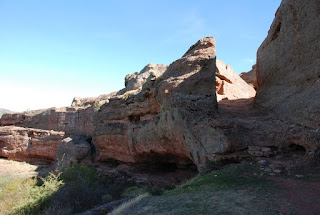Les and Les had been following last year’s cycle route down
through Spain but lady Les had read about the nearby town of Jerez de los Caballeros
and thought that it was worth a detour to visit. Les and Les drove up into the
walled town but we thought that the lower town was a better place to park the
van. Walking up through the narrow streets to meet them confirmed that we had
made the correct decision.
We found the tourist information office and Les and I walked
in to obtain a town map and find out about the sights to visit. Meanwhile, the
ladies walked through the door next to the office, up the stairs to the landing
where they found a lady mopping her landing! There were mumbled apologies
followed by a quick retreat. I will say nothing about ladies and their sense of
direction.
When we visited Jerez last year, all of the churches were
closed and the lady in the tourist information office told us that it was still
the case. However, the castle area was open and we headed there. Last year we
had done the tour of the sights in the rain but now it was sunny and this made
the visit to the castle much more enjoyable. There is very little of the castle
remaining, just the walls and towers, the hill now being occupied by municipal buildings
but there are some very pleasant gardens and lovely views over the surrounding
countryside. The information board told us that the castle was occupied by the
Knights Templar and when they were dissolved in the 14th century,
they resisted and refused to renounce the Order. The castle was put under siege
by royal troops and eventually the knights were corned in the Tower of Homage.
After capture, the army cut the throats of the knights and through their bodies
from the tower. The tower was then renamed the Bloody Tower.
Les and Les retraced their route to get back to the EX101
and the cycle route whilst we headed south. The scenery in this area is quite
beautiful with thousands of pine trees that last year I christened ‘Pompom
trees’ but have now decided to name ‘Blown-out Umbrella trees’ as there is a
tall, straight, branchless trunk until the branches suddenly come out at an
acute angle to produce a rounded, green canopy.
We travelled on past the turning to Minas de Riotinto where
we stopped last year but even from the main road the massive mine workings were
clearly visible. Turning south east at Valverde, we eventually crossed the E1
and headed south for El Rocio where we were going to meet up again with Les
& Les.
We stayed at El Rocio last year after we had flown back to
pick up the van and recommended it to Les & Les. It is a pilgrimage town,
created especially for a pilgrims who come to the Sanctuary of the Virgin of
the Dew. Needless to say, legend has it that a shepherd found a statue of the
virgin in the hollow of a tree trunk and this was the start of the cult. There
was a church on the site in the 13th century but the current
sanctuary dates to the 1960s and the town itself is modern with religious
societies from all over Spain having built large buildings to house pilgrims
when they visit. Every weekend a number of these societies will visit El Rocio
bringing with them their own statues that they then carry in a procession to
the sanctuary. However, the biggest pilgrimage is at Whitsun each year when one
million (!!) pilgrims descend on the small town. Many of the pilgrims come on
horseback across the neighbouring national park together with Wild West style covered
wagons – the Spanish took covered wagons to the New World. The Wild West theme
doesn’t stop there as the whole town has sand-covered streets (no asphalt) and
outside every house and bar there are rails to tie up horses.
Last year the town was deserted but was now weekend and as we
walked from our campsite to Les & Les’ hotel we saw groups of people sat
outside some of the houses and bars. One religious group had arrived and were
unloading the statue and other trappings for their procession; flamenco guitar
and singing was coming from a group sat in a bar and everywhere there were
horses. Often the horses are left to roam through the streets, grazing where
they find grass. We saw one horse that we assumed was one of these until we
noticed that it had a saddle but no rider. Seconds later we saw a Range Rover
in hot pursuit trying, unsuccessfully, to head off the horse and then we saw
the rather disgruntled-looking rider trudging back. After wandering around with
Les & Les, we settled on a restaurant and had a very good meal.
Photos: Les & Les meet an important man in Jerez; The
Bloody Tower; The lower town of Jerez with wall towers peeping out from between
the modern buildings; The two horse riders were on their mobile phones until
they came closer and saw that I was about to take a photograph, then they
lowered their phones to pose – perhaps it is illegal to use the mobile phone
whilst riding in Spain?; Pilgrimage building belonging to the Hermandad (literally
‘Holy Botherhood’) of Bullollus, a local town; Dust rises from a covered wagon
as it disappears down the sandy street.


















































